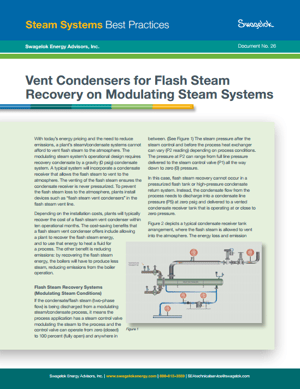 With today’s energy pricing, proactive plant managers are looking to recover any flash steam. Get this article on best practices.
With today’s energy pricing, proactive plant managers are looking to recover any flash steam. Get this article on best practices.The modulating steam system’s operational design requires recovery condensate by a gravity (0 psig) condensate system.
A typical system will incorporate a condensate receiver that allows the flash steam to vent to the atmosphere. The venting of the flash steam ensures the condensate receiver is never pressurized. To prevent the flash steam loss to the atmosphere, plants install devices such as “flash steam vent condensers” in the flash steam vent line.
Depending on the installation costs, plants will typically recover the cost of a flash steam vent condenser within ten operational months. The cost-saving benefits that a flash steam vent condenser offers include allowing a plant to recover the flash steam energy, and to use that energy to heat a fluid for a process. The other benefit is reducing emissions: by recovering the flash steam energy, the boilers will have to produce less steam, reducing emissions from the boiler operation.
About flash steam recovery in modulating conditions
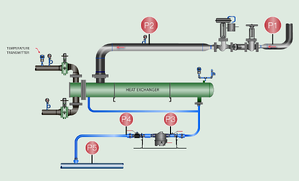
If the condensate/flash steam (two-phase flow) is being discharged from a modulating steam/condensate process, it means the process application has a steam control valve modulating the steam to the process and the control valve can operate from zero (closed) to 100 percent (fully open) and anywhere in between. (See Figure 1)
The steam pressure after the steam control and before the process heat exchanger can vary (P2 reading) depending on process conditions. The pressure at P2 can range from full line pressure delivered to the steam control valve (P1) all the way down to zero (0) pressure.
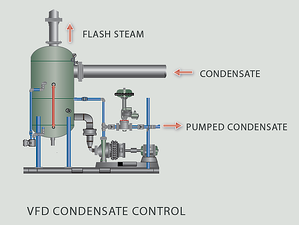 In this case, flash steam recovery cannot occur in a pressurized flash tank or high-pressure condensate return system. Instead, the condensate flow from the process needs to discharge into a condensate line pressure (P5) at zero psig and delivered to a vented condensate receiver tank that is operating at or close to zero pressure.
In this case, flash steam recovery cannot occur in a pressurized flash tank or high-pressure condensate return system. Instead, the condensate flow from the process needs to discharge into a condensate line pressure (P5) at zero psig and delivered to a vented condensate receiver tank that is operating at or close to zero pressure.
Figure 2 depicts a typical condensate receiver tank arrangement, where the flash steam is allowed to vent into the atmosphere. The energy loss and emission factors today do permit this loss in the system.
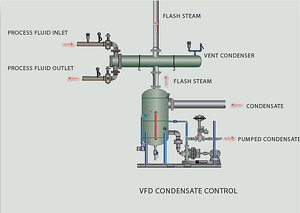 As seen in Figure 3, the system incorporates a flash steam vent condenser in the system to recover the flash steam by using an external heat exchanger (condenser). The vent condenser (heat exchanger) will consume the flash steam by heating air, water, or other process fluids. The vent condenser designed for the application ensures proper operation. A standard shell and tube heat exchanger functions in this application. The process fluid consumes the flash steam and allows the condensate to drain back into the condensate tank. Therefore, it consumes the flash steam and the condensate is recovered. In the case of a modulating steam process condition, the process steam system should use the lowest steam pressure, therefore producing the least amount of flash steam.
As seen in Figure 3, the system incorporates a flash steam vent condenser in the system to recover the flash steam by using an external heat exchanger (condenser). The vent condenser (heat exchanger) will consume the flash steam by heating air, water, or other process fluids. The vent condenser designed for the application ensures proper operation. A standard shell and tube heat exchanger functions in this application. The process fluid consumes the flash steam and allows the condensate to drain back into the condensate tank. Therefore, it consumes the flash steam and the condensate is recovered. In the case of a modulating steam process condition, the process steam system should use the lowest steam pressure, therefore producing the least amount of flash steam.
Condenser
The shell and tube heat exchanger designed for a condenser application is the typical heat transfer design used in flash steam condensers. Other appropriate heat exchanger units are spiral, plate and frame, and fin coil units (heating units for air or process gases). Materials and installation considerations will vary depending on the application. All vented condensers are engineered for a specific application.
Fluid for the condenser
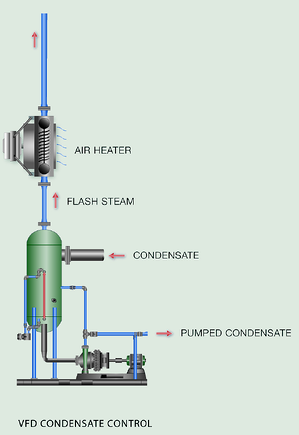 To condense the flash steam, the condenser requires a fluid temperature of less than 160°F (71°C) (general consideration). The fluid can be a liquid or vapor, depending on the application. If there is an insufficient quantity of cooling fluid for the flash steam in a liquid cooling system, then the plant should consider using a flash steam bypass or some other method to prevent the cooling liquid from absorbing too much energy and changing from a liquid to a vapor and causing water hammer.
To condense the flash steam, the condenser requires a fluid temperature of less than 160°F (71°C) (general consideration). The fluid can be a liquid or vapor, depending on the application. If there is an insufficient quantity of cooling fluid for the flash steam in a liquid cooling system, then the plant should consider using a flash steam bypass or some other method to prevent the cooling liquid from absorbing too much energy and changing from a liquid to a vapor and causing water hammer.
Heating air is another application for a vent condenser. Figure 4 shows the air passed over a tube fin configuration with the flash steam inside the tube. The lower temperature air condenses the flash steam and allows the condensate to drain back into the condensate tank.
Pressure on the condensate tank
In choosing the design of the vent condenser, the plant must ensure it chooses a design that does not create significant pressure for the condensate receiver tank. The flash steam vent line from the condensate tank to the condensing unit velocities should not exceed 900 feet per minute.
Required information
To have a successful vent condenser purchase, installation, and operation, the plant should know the following parameters:
Road map
Fill the form on this page to get this article as a PDF.
About Swagelok Northern California
Swagelok Northern California is a locally owned sales and service center of Swagelok, a $2 billion privately held developer of fluid system products, assemblies, and services for the oil and gas, chemical and petrochemical, semiconductor, and transportation industries. We have locations in Fremont and Concord, CA (USA). Phone: 510-933-6200.
—
Copyright © 2011-2024 Swagelok Northern California. All Rights Reserved.